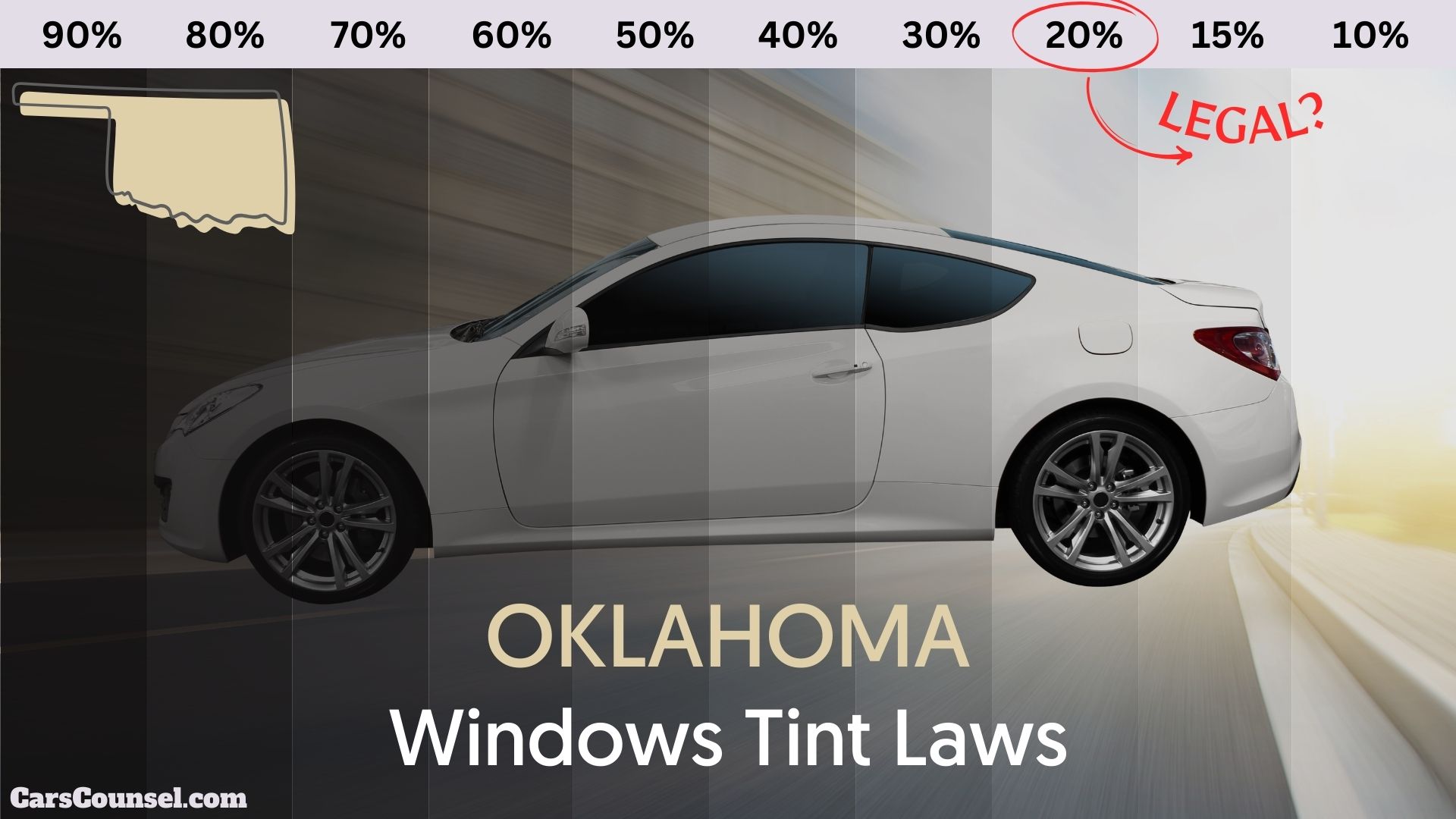As you prepare to hit the open roads of Oklahoma, you’ll want to make sure your vehicle’s window tinting meets the state’s specific regulations. Did you know that the darkness of your window tint depends on the type of vehicle you drive? For instance, sedans require a lighter tint than SUVs and vans.
But that’s not all – there are also rules about reflective tints and exemptions for certain medical conditions.Are you aware of the fines you could face if you don’t comply? You’ll want to know the details to avoid getting pulled over and facing penalties.

Quick Navigation
Window Tint Darkness Regulations
When it pertains to window tinting in Oklahoma, one of the most critical aspects to ponder is the level of darkness permitted on your vehicle’s windows.
The VLT percentage, which measures the amount of light allowed to pass through the window film, determines the legal window tint darkness.
For sedans, the Oklahoma window tint laws allow a tint with a VLT of 25% or lighter on the front and back side windows, and rear window.
SUVs and vans, on the other hand, can have a tint with a VLT of 25% or lighter on the front side windows, and any darkness on the back side windows and rear window.
| Oklahoma Window Tint Law | ||
|---|---|---|
| Window | Sedan | MPV |
| Windshield | AS-1 | AS-1 |
| Front Side | 25% | 25% |
| Back side | 25% | Any |
| Rear window | 25% | Any |
[carscounsel_tint_calculator show_state=”true” default_state=”OK”]
Window Tint Reflection Rules
Verify Oklahoma’s window tint reflection rules to certify your vehicle complies with the state’s regulations.
Oklahoma’s window tint laws dictate that your vehicle’s window tint mustn’t be reflective. A non-reflective tint is required to avoid window tint violations.
The Visible Light Transmission (VLT) percentage determines the level of reflection. For side windows, the VLT must be above 25%.
Rear windows have no VLT restrictions, but they mustn’t be mirrored or metallic.
Windshield tint is only allowed above the AS-1 line, and it mustn’t be reflective.
Review Oklahoma’s window tint laws, which are enforced, and violations can result in fines.
Certify your vehicle meets these reflection rules to avoid any issues.
Oklahoma Window Tint Exemptions
Your vehicle may qualify for Oklahoma window tint exemptions, which allow you to install tints that wouldn’t normally comply with the state’s regulations.
Oklahoma’s window tint laws provide medical exemptions for drivers with certain medical conditions that require them to be protected from the sun. If you have a medical condition, you can obtain a special permit to install a darker window tint with a lower Visible Light Transmission (VLT) percentage.
Exemptions for special cases are allowed above the manufacturers’ recommendations, but you’ll need to provide documentation from a licensed physician. Law enforcement may request to see your permit, so be sure to carry it with you.
Oklahoma Law outlines specific guidelines for exemptions for window tinting, so review the regulations carefully to guarantee conformity.
Violation Penalties and Enforcement
Failing to comply with Oklahoma’s window tint laws can result in serious consequences, including fines, vehicle impoundment, and even points on your license.
If you’re caught with non-compliant window tint, you’ll face penalties such as fines ranging from $20 to $100 for first-time offenders. Repeat offenders can expect fines up to $500.
Law enforcement may give you a notice or fix-it ticket, allowing you time to remove the non-compliant tint. However, repeated offenses or failure to comply can lead to increased fines and other legal consequences.
Accruing points due to violations can even result in a suspension of your driving privileges. Make sure your window tint meets Oklahoma’s laws to avoid these consequences.
Medical Exemptions and Certifications
You may be wondering if Oklahoma’s window tint laws provide any exceptions for individuals with certain medical conditions.
The answer is yes, Oklahoma allows medical exemptions for individuals who require a higher VLT (Visible Light Transmission) due to their medical condition. To qualify, you’ll need to obtain a certification from a licensed medical professional stating that you require a specific VLT to alleviate your condition.
- Certification: You must have a written certification from a licensed medical professional stating your medical condition and the required VLT.
- Medical Conditions: The law allows exemptions for individuals with conditions such as porphyria, albinism, or other conditions that require limited exposure to sunlight.
- VLT Requirements: The certification must specify the minimum VLT required for your vehicle’s windows, which may exceed the standard 25% VLT allowed under Oklahoma law.
- Allowed Window Tints: With a valid certification, you’re allowed to install window tints that meet your specific VLT requirements, even if they don’t meet the standard regulations.
Tint Law References
Car Window Tinting Laws By State
Click on the state you’re interested in for a complete guide to its tint laws and regulations. If you spot any errors, let us know through our contact page.
| State | Front Side Windows | Back Side Windows | Rear Windows | Windshield |
|---|---|---|---|---|
| Alabama | 32% | 32% | 32% | 6 inches |
| Alaska | 70% | 40% | 30% | 5 inches |
| Arizona | 33% | ANY | ANY | tinting allowed to the top of the manufacturer’s as-1 line |
| Arkansas | 25% | 25% | 10% | 5 inches |
| California | 70% | ANY | ANY | 4 inches |
| Colorado | 27% | 27% | 27% | 4 inches |
| Connecticut | 35% | 35% | ANY | non-reflective tint above the as-1 line top 6 inches |
| Delaware | 70% | ANY | ANY | non-reflective tint above the as-1 line top 6 inches |
| Florida | 28% | 15% | 15% | non-reflective tint above the as-1 line |
| Georgia | 32% | 32% | 32% | 6 inches |
| Hawaii | 35% | 35% | 35% | Non-reflective tint is allowed on the top 4 inches of the windshield |
| Idaho | 35% | 20% | 20% | non-reflective tint above the as-1 line |
| Illinois | 35% | 35% | 35% | 6 inches |
| Indiana | 30% | 30% | 30% | non-reflective tint above the as-1 line |
| Iowa | 70% | ANY | ANY | non-reflective tint above the as-1 line |
| Kansas | 35% | 35% | 35% | non-reflective tint above the as-1 line |
| Kentucky | 35% | 18% | 18% | non-reflective tint above the as-1 line |
| Louisiana | 40% | 25% | 12% | non-reflective tint above the as-1 line top 6 inches |
| Maine | 35% | 35% | 35% | top 4 inches |
| Maryland | 35% | 35% | 35% | top 5 inches |
| Massachusetts | 35% | 35% | 35% | top 6 inches |
| Michigan | 35% | ANY | ANY | top4 inches |
| Minnesota | 50% | 50% | 50% | Top 6 inches |
| Mississippi | 28% | 28% | 28% | non-reflective tint above the as-1 line top 5 inches |
| Missouri | 35% | ANY | ANY | non-reflective tint above the as-1 line top 6 inches |
| Montana | 24% | 14% | 14% | non-reflective tint above the as-1 line top 6 inches |
| Nebraska | 24% | 20% | 20% | top 6 inches or as-1 line, whichever comes first |
| Nevada | 35% | ANY | ANY | non-reflective tint above the as-1 line top 6 inches |
| New Hampshire | 35% | 35% | 35% | Allowed for the manufacturer’s AS-1 line |
| New Jersey | Illegal | ANY | ANY | Top 6 inches |
| New Mexico | 20% | 20% | 20% | 5 inches or as-1 line, whichever comes first |
| New York | 70% | 70% | 70% | top 6 inches |
| North Carolina | 35% | 35% | 35% | non-reflective tint above the as-1 line top 6 inches |
| North Dakota | 50% | ANY | ANY | Top 6 inches |
| Ohio | 50% | ANY | ANY | Top 5 inches |
| Oklahoma | 25% | ANY | ANY | 5 inches or as-1 line, whichever comes first |
| Oregon | 35% | 35% | 35% | Top 6 inches |
| Pennsylvania | 70% | 70% | 70% | Top 3 inches |
| Rhode Island | 70% | 35% | 35% | non-reflective tint above the as-1 line top 6 inches |
| South Carolina | 27% | 27% | 27% | non-reflective tint above the as-1 line top 6 inches |
| South Dakota | 35% | 20% | 20% | non-reflective tint above the as-1 line top 6 inches |
| Tennessee | 35% | 35% | 35% | non-reflective tint above the as-1 line top 6 inches |
| Texas | 25% | 25% | 25% | 5 inches or as-1 line, whichever comes first |
| Utah | 43% | ANY | ANY | non-reflective tint above the as-1 line top 4 inches |
| Vermont | 70% | ANY | ANY | ILLEGAL |
| Virginia | 50% | 35% | 35% | non-reflective tint above the as-1 line top 6 inches |
| Washington | 24% | 24% | 24% | Top 6 inches |
| West Virginia | 35% | 35% | 35% | Top 5 inches |
| Wisconsin | 50% | 35% | 35% | non-reflective tint above the as-1 line top 6 inches |
| Wyoming | 28% | 28% | 28% | Top 5 inches or as-1 line, whichever comes first |

